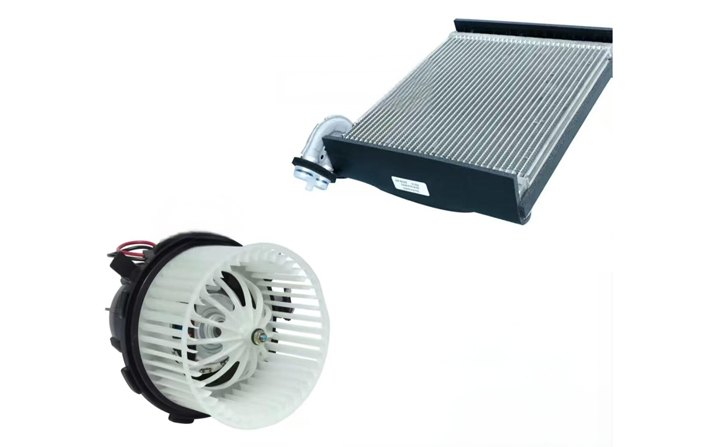Evaporator + Blower: The Dual Factors in Vehicle Air Conditioning Delivery Efficiency.
2025-07-09
During scorching summers, an efficient vehicle air conditioning (A/C) system is fundamental to driving and passenger comfort. The ultimate cooling effect relies not only on the compressor's refrigeration capacity but critically on how effectively the cold air is "generated" and efficiently delivered throughout the cabin. The evaporator is responsible for "generating" the cold air, while the blower handles the crucial task of "delivering" it. Functioning like the "heart and lungs" of the cooling system, their synergistic efficiency directly determines the final cabin cooling experience.

I. The Cold Air Generator: The Evaporator
The evaporator is the core heat exchange component in the automotive A/C system, acting as the "cold source."
1. Core Tasks: Heat Exchange & Dehumidification: High-pressure liquid refrigerant from the compressor expands and evaporates (phase change) here, absorbing significant heat. This rapidly cools the warm, humid air flowing over the evaporator's fin surfaces. Water vapor in the air condenses upon contact with the cold fins and is drained away, achieving dehumidification – key to obtaining dry, cool air.
2. Efficiency Cornerstones: Design & Heat Transfer: Modern evaporators typically utilize multi-row parallel flow designs. Internal microchannel tubes combined with extensive external aluminum fins maximize heat exchange efficiency. Maintaining clean fin surfaces (avoiding dust/oil blockage) and precise control of internal refrigerant flow rate and pressure are essential for efficient heat absorption and achieving the optimal evaporator temperature (typically 0-4°C, preventing frost formation). An efficient evaporator ensures air is thoroughly cooled upon contact.
II. The Cold Air Deliverer: The Blower
The blower acts as the "lungs" of the A/C system; its performance dictates the cold air's coverage and intensity.
1. Core Task: Driving Airflow: The blower motor drives a fan wheel, generating powerful airflow. This forces cabin air (recirculation mode) or outside air (fresh air mode) through the cold evaporator fins for cooling. The generated cold air is then pushed through ducts to the various vents.
2. Efficiency Keys: Airflow & Pressure:
Airflow (CFM - Cubic Feet per Minute): Represents the volume of air moved per unit time, directly determining the "total output" of cold air. Sufficient airflow is crucial for rapidly lowering cabin temperature and maintaining even temperature distribution.
Air Pressure: Represents the airflow's ability to overcome resistance within the system (e.g., duct bends, cabin air filter restriction, vent grilles). Adequate pressure ensures cold air effectively penetrates the filter, flows smoothly through complex ducting, and reaches distant (like rear footwells) or high-resistance vents. Modern blowers often employ centrifugal designs combined with efficient brushless DC motors and PWM (Pulse Width Modulation) speed control. This allows precise delivery of required airflow and pressure while reducing noise and energy consumption.
III. Synergistic Effect: Efficiency Gains Beyond 1+1
The evaporator and blower do not work in isolation; their synergistic efficiency is paramount to the final cooling delivery.
1. Optimal Matching Design: Engineers must precisely match the blower's airflow/pressure characteristics to the evaporator's air-side resistance profile and heat transfer capacity. Insufficient airflow causes low air velocity over the evaporator fins, leading to poor heat transfer (cold air is "made" but not carried away). This results in low cooling efficiency and risks evaporator frosting. Excessive airflow beyond the evaporator's heat transfer capacity can lead to insufficiently cold outlet air, along with increased noise and energy waste.
2. Optimized Airflow Distribution: The airflow generated by the blower must be evenly distributed across the entire face of the evaporator core. Avoiding "short-circuiting" or localized low-velocity zones is essential to maximize the utilization of the evaporator's heat transfer surface area. Factors like evaporator core cleanliness, rational duct design (minimizing turbulence and pressure drop), and regular cabin air filter replacement (maintaining low resistance) directly impact the blower's effective output and the overall synergy. Efficient synergy means delivering more, colder air efficiently and quietly to the passengers' desired locations with the same energy input.
Summary
The experience of cool comfort inside a vehicle stems from the precise synergy between the evaporator efficiently *generating* cold air and the blower effectively *delivering* it. These two components function as the twin engines of the cooling system; neither can be neglected. Optimizing the evaporator's heat exchange performance, ensuring the blower provides sufficient and well-matched airflow and pressure, and achieving the best possible synergistic design between them are the core factors in enhancing vehicle A/C cooling delivery efficiency and creating a comfortable driving environment. Understanding and properly maintaining this "golden partnership" is key to staying cool on summer drives.